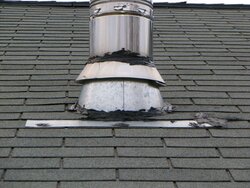Hello everyone,
I had my woodstove installed about 3 years ago. It has a square ceiling support box that protects the pipe from the insulation in the ceiling. It is all double walled pipe. The last couple of rain storms there has been water coming through the box along the edges and corners that are spot welded together. There is nothing coming down along the pipe as far as I can tell, only out of the box. I went up and slathered silicone on the storm collar and everything else I could see as suspicious but it did not fix the problem. Any thoughts on what to do next? Where would you guess the leak is?
Thanks for the advice.
joe
I had my woodstove installed about 3 years ago. It has a square ceiling support box that protects the pipe from the insulation in the ceiling. It is all double walled pipe. The last couple of rain storms there has been water coming through the box along the edges and corners that are spot welded together. There is nothing coming down along the pipe as far as I can tell, only out of the box. I went up and slathered silicone on the storm collar and everything else I could see as suspicious but it did not fix the problem. Any thoughts on what to do next? Where would you guess the leak is?
Thanks for the advice.
joe



